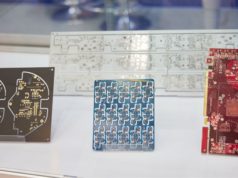
- Register
- Login
37°C
- Article
- . (0)
- Related content
Shipments of bezel-free or alternative aspect ratio smartphones will exceed 120 million units in 2017, and will more than triple in 2018, according to Counterpoint Research.
In a quest for increased display sizes and new forms of hardware differentiation, leading smartphone OEMs are turning to new solutions to increase the effective display viewing area without increasing the overall physical size of the devices, said Counterpoint.
Commenting on latest trend of 18:9 displays in smartphones, Counterpoint Research director Peter Richardson noted “with the rise of super-fast 4G networks and beyond, smartphones have become the primary devices for content creation and consumption, driving demand for bigger displays. Clearly, there is a practical limit to the physical size of a smartphone, typically determined by the size of the user’s hands or pockets.”
“As a result, rather than increase the size of the display, handset OEMs are turning to solutions that increase the effective viewing area of the display without increasing the overall size of the phone,” Richardson continued. “These include bezel-less designs and new aspect ratios. Yet another solution, available in the near future, will be that of foldable displays, which could allow a 10-inch tablet-sized displays to be folded and accommodated in a compact 5.5-inch smartphone-sized design.”
With Sharp’s Aquos, the market has already seen one of the first phones trying to break shackles on bezels in 2014. However, it was not successful due to limited roll-out, poor battery life and a bulky design. So was Xiaomi’s Mi Mix, launched in 2016 with much fan-fare but bench marked heavily on Sharp’s initial design. While more of a proof of concept and only available in limited quantities, it also suffered from a bulkiness that deterred many. Fast forward to 2017, the vertically integrated Korean smartphone brands LG and Samsung, leveraging their display business and technologies, are getting it right, Counterpoint indicated.
The LG G6 sports a beautiful LCD-based 18:9 display and Samsung’s Galaxy S8 series shows-off a much brighter, color-rich, curved OLED display. Apple is rumored to also launch an OLED version bezel-less display in its “special edition” smartphone later in 2017, marking its tenth anniversary for the iPhone. This should drive the bezel-free or alternative aspect ratio trend into a high scale and high demand feature. Next year’s flagships from competing brands will have to toe the line or risk being marginalized, Counterpoint said.
As with most areas of hardware differentiation, with few suppliers controlling OEMs’ access to this technology, the sustainability of the differentiation is levered to availability and supply. For 2017 both are likely to be limited, meaning that only those that gain access to the technology will be able to eke out some level of differentiation.
“While every brand would like to join the bandwagon, there will be serious supply constraints this year and first half of next year to match the demand,” said Counterpoint Research director Tom Kang. “This will keep prices high and also enable deep-pocketed OEMs to lock-in the major part of supply. However by 2018 supply and availability issues should ease, and the amount of content formatted for 18:9 aspect ratio displays will become more widespread, leading to greater adoption.”
Samsung Display, JDI, LG Display should be the major beneficiaries, alongside display driver IC players, Kang indicated. China-based display manufacturers such as Tianma, BOE will also likely contribute by supplying these new wider, bezel-free displays to a growing crop of China-based brands in the latter part of 2018, Kang said.
Counterpoint forecasts more than 120 million smartphones including these differentiated alternative aspect ratio and near bezel-free displays will ship in 2017, accounting for almost 7% of the total smartphone shipments this year. This demand will more than triple in 2018 as supply issues ease and more OEMs will be able to offer bezel-free flagship models in their portfolio in the second half of 2018.



- Wireless broadband developments in Southeast Asia markets
As of 2013, the 10 ASEAN nations had a total of over 700 million mobile subscriptions, with the CAGR from 2003-2013 reaching 24%. This Digitimes Research Special Report analyzes the various mobile broadband markets in ASEAN and looks at the respective trends in 4G LTE development for those markets.
- 2015 global tablet demand forecast
This Digitimes Research Special Report provides a 2015 forecast for the global tablet market and analyzes the strategies of key market players such as Google, Apple, Intel, and Microsoft.
- 2015 China smartphone panel trend forecast
This Digitimes Research Special Report analyzes the strategies of key China-based major panel makers BOE, Tianma and IVO for attacking the different market segments through technology and pricing, and their relationship to local vendors Huawei, Lenovo, ZTE, Xiaomi and Coolpad.








